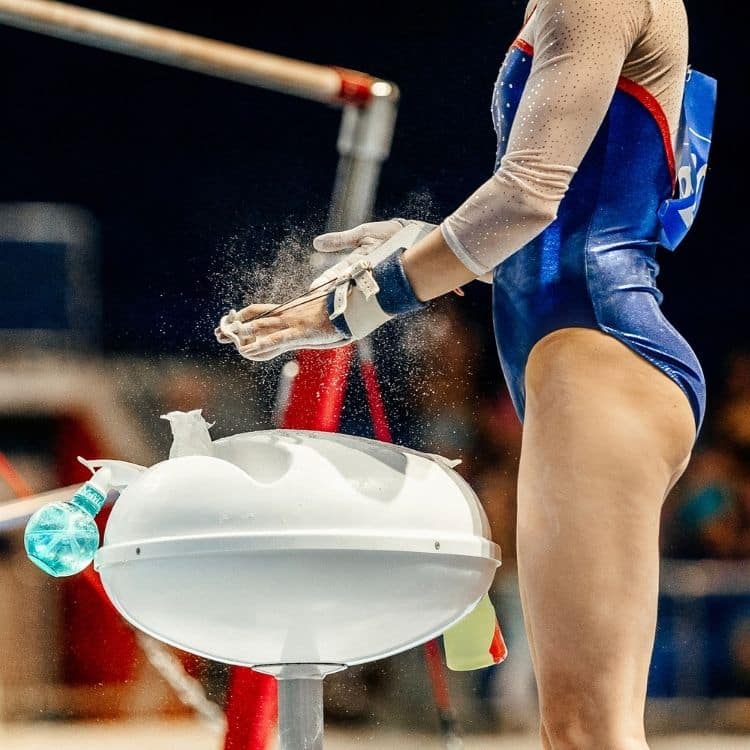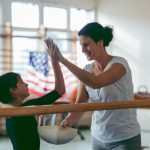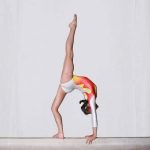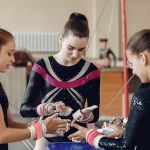Gymnastics bar moves are considered some of the hardest in the whole of the sport due to the immense strength and flexibility needed to perform them well. This guide focuses on bar moves performed by female gymnasts on Uneven bars, though there are some cross-overs with the male horizontal bar. The other set of bars that male gymnasts use, the Parallel Bars, is not covered in this article.
All skills are listed in alphabetical order.

Backward Giant Circle to a 180 Degree Twist
This move involves a gymnast performing a giant circle backward on the bar and then twisting 180 degrees in the air before regrasping the bar. It requires excellent timing and body control.
Backwards Hip Circle
The back hip circle is a skill that requires you to swing your hips around the bar in a circular motion. This exercise helps you build strength and flexibility in your hips and legs. To perform the back hip circle, follow these steps:
- Start in the front support position
- Pike your legs in front of you slightly then swing your legs backwards trying to clear your hips from the bar
- As your legs come back down use the momentum to swing under the bar
- Try to hit the candlestick position as your feet eventually point towards the ceiling and you are upside down
- Keep pulling in towards the bar and keep the momentum going or you will not be able to get your legs over the bar
- Finish back in the support position
Practice the support, pike and candlestick shapes regularly to master the back hip circle.
Backwards Sole Circle
This skill involves the gymnast circling backward around the bar with their soles making contact with the bar. It’s a foundational skill for more complex movements.
Bhardwaj (Full-twisting Pak Salto)
Named after Indian gymnast Mohini Bhardwaj, this advanced move, first performed in 2004, is a Pak Salto with a full twist. It’s known for its complexity and elegance.
Blind Change
The Blind Change is a turning skill where the gymnast rotates 180 degrees while in a handstand on the bar. It’s a difficult skill but once mastered will allow gymnasts to switch the direction of their swing and add a wider range of skills to their routine.
Cast
A fundamental skill, the cast involves the gymnast moving from a front support position on the bar into a handstand. It’s essential for transitioning into higher-level skills.
Cast to Handstand
This skill is an extension of the basic cast, where the gymnast casts up into a handstand position. It requires strength and control.
Cast to Horizontal
In the Cast to Horizontal, the gymnast casts up and levels out in a position parallel to the ground, requiring core strength and control. It’s easier than Cast to Handstand as the gymnast is only extending into a level position rather than completely upside down.
Church (Piked Tkatchev)
The Church, a variation of the Tkatchev, involves a piked somersault backward over the bar. It’s named after American gymnast Ashton Locklear.
Clear Hip Circle
This skill involves the gymnast circling around the bar while maintaining a clear hip position, crucial for developing fluidity and rhythm.
Comaneci Salto
Named after the legendary Nadia Comaneci, this move involves a frontward salto over the high bar from a toe-on start. It’s historic for its innovation and difficulty.
Deltchev (Straddled Tkatchev)
The Deltchev, invented by Bulgarian gymnast Stoyan Deltchev, involves a straddle flip over the bar from a backward giant. It’s noted for its dynamic execution.
Endo with Half Turn
This move is a backward giant around the bar into a straddle position with a half turn at the top of the swing, requiring precise body control and grip changes.
Front Giant
The Front Giant involves a forward giant swing, where the gymnast maintains a handstand position while circling the bar. It’s key for developing momentum.
Geinger (Reverse Hecht)
Named after German gymnast Eberhard Gienger, this move is a backward salto with a half twist over the bar, known for its aerial dynamics.
Giant
The Giant is a fundamental skill where the gymnast performs a full 360-degree rotation around the bar in a handstand position, essential for building momentum.
Hindorff (Straddled Tkatchev to High Bar)
This advanced move, named after East German gymnast Silvia Hindorff, involves a straddled flip to regrasp the high bar. It’s known for its high difficulty level.
Jaeger (Front Flip Catch)
The Jaeger, a front flip catch over the bar, was popularized by German gymnast Bernd Jäger. It’s a visually stunning move requiring precise timing.
Khorkina (Stalder to Blind with Change of Grip)
Named after Russian gymnast Svetlana Khorkina, this complex move involves a stalder into a blind change with a grip switch, showcasing exceptional flexibility and skill.
Kip
The kip is a skill that requires you to swing your legs back and forth as you move your body towards and away from the bar. This exercise helps you build momentum and improve your overall body control. To perform the kip, follow these steps:
- Stand facing the bar with your arms extended above your head and your feet shoulder-width apart.
- Jump up and grab the bar with your palms facing away from your body. Try and hit a pike shape.
- Swing under the bar in a Pike shape then glide into a more open pike shape by the end of the swing.
- Lift your toes and legs towards the bar
- As your legs come back down, use the momentum to lift and pull up and over the bar. Adjust your wrist position at the same time.
- Hold yourself up in the support shape to finish.
Practice the kip regularly to build your momentum and improve your overall body control.
Leg Cut
The single leg cut is a skill that requires you to swing your legs underneath the bar as you release your grip and jump back down. This exercise helps improve your overall body control and coordination. To perform the single leg cut, follow these steps:
- Stand facing the bar with your arms extended above your head and your feet shoulder-width apart.
- Jump up and grab the bar with your palms facing away from your body.
- Keep your arms straight and your body close to the bar as you pull yourself up and into a squat position.
- Release one hand from the bar and swing your legs underneath the bar.
- As you swing your legs, release your grip with the other hand and jump back down.
Practice the single leg cut regularly to improve your overall body control and coordination.
Long Hang Kip
The Long Hang Kip involves the gymnast moving from a long hang position into a front support on the bar, requiring core strength and precise timing.
Mill Circle
This skill involves the gymnast circling the bar with their legs in a straddle position, rotating around the bar. It helps develop coordination and strength.
Ono (Full Pirouette in El-Grip)
Named after Japanese gymnast Takashi Ono, this move involves a full pirouette in an el-grip on the high bar. It requires advanced grip strength and control.
Pak Salto (Backwards Flip from High to Low Bar)
The Pak Salto, named after North Korean gymnast Pak Gyong Sil, is a backwards flip from the high bar to the low bar, known for its smooth execution.
Piked Stalder
This move involves a piked body position while performing a stalder circle. It requires flexibility and precise body control.
Pull Over
A fundamental skill for beginners, the Pull Over involves the gymnast pulling over the bar from a hang to a front support position.
Pull up from hang
The pull up from hang is a skill that requires you to pull your body up towards the bar using only your upper body strength. This exercise helps build strength in your arms, shoulders, and back. To perform the pull up from hang, follow these steps:
- Stand facing the bar with your arms extended above your head and your feet shoulder-width apart.
- Jump up and grab the bar with your palms facing away from your body.
- Keep your arms straight and your body close to the bar as you pull yourself up and into a squat position.
- Slowly release your grip and hang from the bar with your arms extended.
- Begin pulling your body up towards the bar, using only your upper body strength.
- Once your chin is above the bar, slowly lower yourself back down to a hang.
Regularly practice the pull up from hang to build strength in your arms, shoulders, and back.
Ray (Toe-on Tkatchev)
Named after American gymnast Elise Ray, this skill involves a toe-on to a Tkatchev, a dynamic and visually impressive move.
Ricna (Stalder Tkatchev)
The Ricna, a variation of the Tkatchev, involves performing a stalder circle and then a backward flip over the bar. It requires significant strength and precision.
Salto Dismount
A common dismount, the Salto Dismount involves performing a salto (flip) off the bar, landing on the mat. It can be executed in various forms.
Seitz (Toe-on Tkatchev with Half Turn)
Named after German gymnast Elisabeth Seitz, this complex skill involves a toe-on to a Tkatchev with a half turn, known for its difficulty and originality.
Shaposhnikova (Free Hip Circle with Flight to High Bar)
Named after Soviet gymnast Natalia Shaposhnikova, this move is a free hip circle with a flight transition to the high bar, showcasing agility and precision.
Shushunova (Stalder Forward to Handstand)
Named after Soviet gymnast Elena Shushunova, this skill involves a stalder forward into a handstand, requiring flexibility and control.
Single Leg Basket Swing
In this move, the gymnast swings one leg in a basket swing under the bar, a fundamental skill for rhythm and timing development.
Squat on the bar
The squat on is a basic skill that requires you to jump onto the bar and hold your body weight with your arms. This exercise helps you build upper body strength and teaches you how to control your body as you balance on the bar. To perform the squat on, follow these steps:
- Stand facing the bar with your arms extended above your head and your feet shoulder-width apart.
- Jump up and grab the bar with your palms facing away from your body.
- Keep your arms straight and your body close to the bar as you pull yourself up and into a squat position.
- Hold the squat position for a few seconds, then slowly release your grip and jump down.
Practice the squat on regularly to build your upper body strength and improve your ability to control your body on the bar.
Stalder Circle
The Stalder Circle involves the gymnast performing a circle around the bar in a stalder position, requiring flexibility and precision.
Straddle Back
This skill involves a straddle movement to move back over the bar, essential for transitioning in routines.
Tkatchev (Reverse Hecht)
The Tkatchev, a classic move in gymnastics, involves a reverse hecht over the bar. It’s a staple in high-level routines for its dynamic execution.
Toe Hecht
The Toe Hecht is a toe-on release move where the gymnast launches over the bar, requiring precise timing and grip strength.
Tucked Jaeger
A variation of the Jaeger, this move involves a tucked front flip to regrasp the bar, showcasing aerial acrobatics.
Underswing Dismount
The Underswing Dismount involves swinging under the bar and releasing into a dismount, a fundamental skill for beginners.
Van Leeuwen (Maloney with Half Turn)
Named after Dutch gymnast Laura van Leeuwen, this move is a Maloney with a half turn to regrasp the high bar, requiring dynamic strength and precision.
Final Thoughts
Gymnastics bar moves are among the most difficult across all of the disciplines, however, with training and maybe some home training, bars can be enjoyed by gymnasts of all ages and abilities.
Sources:
- How to Do a Back Handspring: Complete Step-by-Step GuideLearning how to do a back handspring is an exciting milestone for any gymnast. It builds confidence, agility, and forms the foundation for advanced tumbling… Read more: How to Do a Back Handspring: Complete Step-by-Step Guide
- How To Get Over a Mental Block In Gymnastics: A Complete GuideGymnastics is a sport that requires not only physical strength and skill but also mental strength. When a gymnast feels like they cannot attempt a… Read more: How To Get Over a Mental Block In Gymnastics: A Complete Guide
- The Best Leotard for Girls in 2025: What to Look ForFinding an ideal leotard for girls isn’t just about picking a dazzling design that sparkles (although it does help!). The leotard has to fit perfectly,… Read more: The Best Leotard for Girls in 2025: What to Look For
- The Best Gymnastics Shorts (Our Top Picks)The best gymnastics shorts are designed to be worn over the top of a leotard providing additional coverage around the upper legs, whilst allowing gymnasts… Read more: The Best Gymnastics Shorts (Our Top Picks)
- Decathlon Leotards – Are They Any Good?If you’re in the market for a new leotard, you may be wondering if Decathlon leotards are any good considering the low cost of their… Read more: Decathlon Leotards – Are They Any Good?
- A Complete Guide to Gymnastics Hand RipsAre you tired of dealing with painful gymnastics rips on your hands from training? Look no further – this article offers a comprehensive approach to… Read more: A Complete Guide to Gymnastics Hand Rips






